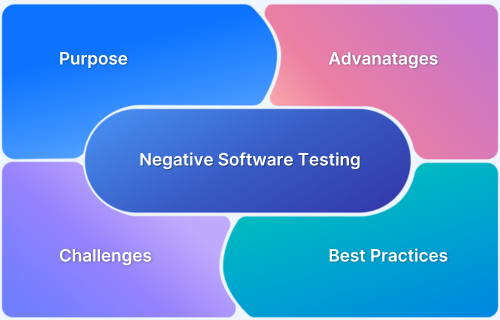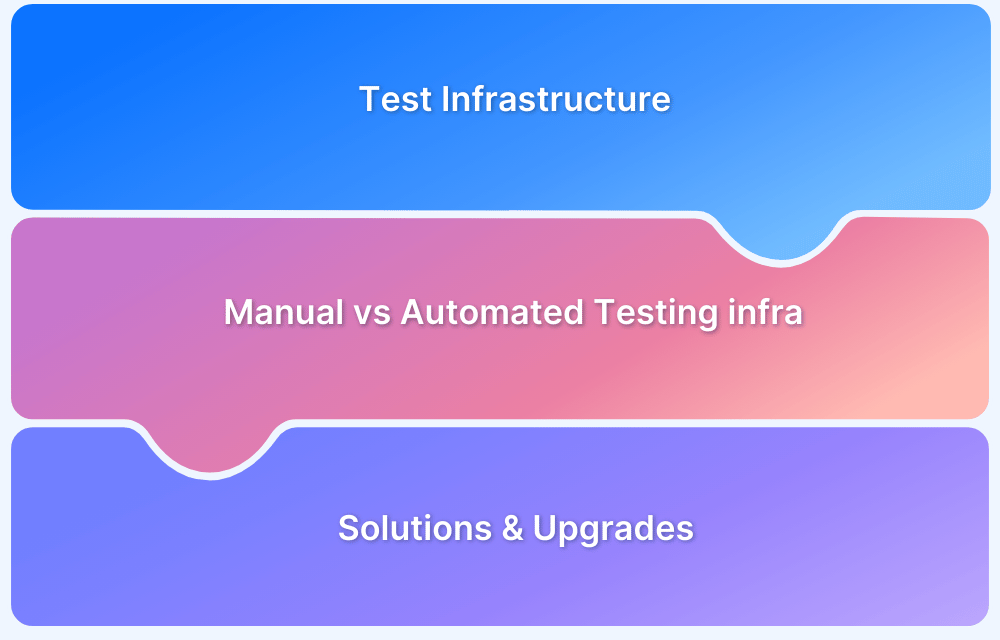Negative testing ensures software can handle invalid or unexpected inputs without failing. It helps identify vulnerabilities, improve error handling, and enhance overall reliability.
Overview
Negative software testing is a testing approach that focuses on validating a system’s behavior when subjected to invalid, unexpected, or incorrect inputs. It ensures that the software gracefully handles errors without crashing.
Purpose of Negative Testing:
- Identifies system vulnerabilities by testing unexpected inputs.
- Ensures the application responds correctly to invalid or boundary conditions.
- Prevents security breaches caused by unhandled errors.
Benefits of Negative Testing:
- Enhances software robustness and reliability.
- Improves security by detecting potential exploit points.
- Reduces post-deployment failures by catching edge cases early.
How Negative Testing Works:
- Testers provide invalid inputs, such as special characters, incorrect formats, or boundary values.
- Observe how the system reacts to error messages, logs, or system behavior.
- Validate if the system handles errors gracefully without breaking functionality.
This article covers negative testing, its purpose, types, test case design, execution, examples, advantages, challenges, best practices, role in SDLC, and how BrowserStack enhances it.
What is Negative Testing?
Negative testing verifies software’s behavior when given invalid, unexpected, or incorrect inputs. It ensures that the application handles errors gracefully without crashing or exposing vulnerabilities.
Testers intentionally use edge cases, boundary values, and incorrect data to check if the system responds correctly with error messages, validations, or fallback mechanisms. This testing approach strengthens software reliability, enhances security, and prevents failures in real-world usage.
Purpose of Negative Testing
Negative testing focuses on uncovering potential bugs, errors, or security vulnerabilities that may not have been identified through positive testing (using valid inputs).
The purpose of negative testing is to evaluate a software system’s behavior when it is subjected to invalid or unexpected inputs.
Here are some major objectives that negative testing can help software developers and testers with:
- Ensures Software Quality Assurance: It is a critical component of software quality assurance, as it helps validate that the system behaves as expected and meets customer requirements.
- Improves System Stability: It ensures that the system behaves gracefully when faced with invalid inputs, providing a better user experience and reducing the risk of user frustration or system failure.
- Detects Hidden Stability Issues: It helps identify and fix stability issues that may not have been discovered through positive testing.
You can use negative testing to verify the robustness of your software by testing how it handles invalid or unexpected inputs.
But different negative tests have different objectives. Let’s understand the major negative testing types.
Types of Negative Testing
There are several types of negative testing, including:
- Boundary value testing: It involves testing the system with inputs that are at the minimum or maximum limits of the input range.
- Input validation testing: You can test the system’s handling of invalid inputs, like invalid data types, out-of-range values, and invalid characters.
- Exception testing: It focuses on testing the system’s handling of exceptional conditions, such as missing data, unexpected shutdowns, and other exceptional events.
- Load testing: It involves testing the system’s behavior under heavy load or stress, such as high traffic conditions or high-volume data processing.
- Compatibility testing: This negative testing checks the system’s compatibility with different hardware, software, and network configurations.
You must design pitch-perfect test cases based on the test you want to perform.
Why is Negative Testing Important?
Negative testing helps build robust applications by identifying weaknesses and improving overall stability. Here is why negative testing is important:
- Identifies System Vulnerabilities: Exposes security flaws and weaknesses that attackers could exploit.
- Prevents System Crashes: Ensures the application remains stable even when users enter invalid or unexpected inputs.
- Strengthens Error Handling: Helps developers implement proper error messages and fallback mechanisms instead of abrupt failures.
- Enhances User Experience: Ensures the software responds gracefully to errors, reducing frustration and improving usability.
- Reduces Risk of Data Corruption: Prevents invalid inputs from causing unintended data loss or system malfunctions.
- Improves Overall Software Quality: Helps detect hidden defects that may not surface in positive testing, ensuring a more robust application.
Designing Negative Test Cases
Designing negative test cases involves identifying scenarios where the system or application should not work as expected and testing it with invalid, unexpected, or incorrect inputs to verify that it handles these scenarios correctly.
Here are the steps to design negative test cases:
- Identify potential negative scenarios: Review the system requirements, use cases, and functionalities to identify potential scenarios where the system may not work as expected.
- Determine the expected outcome: For each negative scenario, determine what the expected outcome should be. For example, an error message or a system shutdown.
- Choose the inputs: Based on the negative scenarios identified, choose the inputs that will trigger the negative behavior. These can be invalid data, incorrect input values, or unexpected inputs.
- Design the test cases: Create test cases that describe the steps to follow to perform the negative testing. The test cases should include the inputs, expected outcomes, and any other relevant information.
Once the design is ready, you can perform or execute the negative testing.
Read More: Understanding Test Case Management
How to Perform Negative Testing?
To perform negative testing, you must consider all the possible cases. If possible, you have to consider every test case irrespective of whether it is the right way to use it. For example, if you see an email field, you must think of all possible inputs a user can put in other than the correct email format.
Here are the standard steps you can follow while performing negative testing:
- Check the designed negative test cases. Ensure it includes invalid inputs, security-related scenarios, and extreme conditions.
- Use manual or automated tools to generate invalid inputs to test the software.
- Monitor the system’s behavior once the negative tests are executed.
- Analyze the results to determine if any issues or weaknesses were uncovered.
- Repeat the process multiple times and document the results of the negative testing.
By following these steps, you can ensure that your negative testing is comprehensive and effective and that it helps to improve the quality, security, and robustness of your system.
Let’s get more clarity by going through multiple real-world examples of negative testing.
Examples of Negative Testing
Consider a case of an online login system. When valid credentials are entered, access is granted to the account.
Now, here are some negative scenarios for the login system:
- What happens if an incorrect username or password is entered?
- What happens if the username or password field is left blank and login is attempted?
- What happens if special characters or SQL injection scripts are entered in the input fields?
All these cases come under negative testing. You can’t ensure that all the above-mentioned cases won’t happen, so you need to contain them.
Apart from the elevator example, here are a few software-related examples of negative testing:
- Testing an eCommerce site’s payment gateway: Enter invalid credit card information or try to exceed the maximum order value to verify that the site handles these scenarios correctly and prevents fraudulent transactions.
- Testing a GPS navigation system: When the tester inputs an incorrect address or tries to use the system in an area with limited or no GPS coverage to verify that the system handles these scenarios correctly and provides clear error messages.
- Testing a website’s login page: You can input incorrect username and password combinations to verify that the website displays the appropriate error message and prevents unauthorized access.
- Testing an ATM machine: Try to withdraw more money than the account balance or insert an invalid card to verify that the machine handles these scenarios correctly and prevents unauthorized transactions.
- Testing a mobile app’s camera function: Take a photo in low-light conditions or without enough storage space on the device to verify that the app handles these scenarios correctly.
These tests can verify the robustness and reliability of software and system in handling unexpected or incorrect inputs.
Advantages and Disadvantages of Negative Testing
Negative testing helps improve software stability and security, but it also comes with certain challenges. Understanding its benefits and limitations is crucial for effectively implementing it in the testing process.
Advantages of Negative testing:
- Negative testing helps identify if the system behaves in an unexpected manner, such as by breaking or producing incorrect results, when it receives invalid or unexpected inputs.
- By uncovering weaknesses in the system, negative testing can help improve the overall quality of the software and make it more robust.
- Uncover security vulnerabilities in the system, such as by exposing weaknesses in the input validation process.
- By testing the system under adverse conditions, negative testing increases confidence in the system’s ability to function correctly in real-world scenarios.
Now that you are aware of the advantages let’s go through the disadvantages.
Disadvantages of Negative Testing:
- Negative testing can be time-consuming, as it often requires extensive testing of edge cases and invalid inputs.
- Automating negative testing can be challenging, as it requires the creation of test cases that accurately represent invalid inputs and the ability to interpret the results.
- Negative testing can only cover a limited set of potential negative scenarios, and it may not be possible to test all possible invalid inputs.
- It can also be resource-intensive, as it may require additional hardware or software to generate and manage invalid inputs.
To minimize the negative impact of the tests, you can follow a few important practices.
Best Practices for Negative Testing
Here are some of the best practices for negative testing.
- Plan your negative testing strategy carefully and determine which scenarios and inputs to test.
- Clearly define the goals and objectives of your negative testing effort and what you hope to achieve by conducting negative testing.
- Test the edge cases and boundary conditions of the system, where invalid inputs are most likely to occur.
- Automate your negative testing process wherever possible to improve efficiency and reduce the risk of human error.
- Use real-world data to generate invalid inputs, whenever possible, to better represent the types of inputs that users are likely to encounter.
Importance of Negative Testing in SDLC
Incorporating negative testing into the SDLC ensures that the software is of high-quality, secure, and fit for purpose and supports ongoing efforts to improve and refine the system. Here are a few benefits of negative testing in SDLC:
- Identifies and addresses weaknesses in the system, which can improve the overall quality of the software and reduce the risk of defects and errors.
- Validates the requirements by ensuring that the system behaves as specified and that invalid inputs are handled correctly.
- Increases confidence in the system by demonstrating its ability to function correctly under adverse conditions and with invalid inputs.
- Mitigate risks associated with the system, such as the risk of data loss or corruption, and ensure that the system meets the needs of the users.
Challenges in Negative Testing
You must be prepared to tackle multiple challenges that can arise during negative testing. Here are a few major ones we have filtered:
- Identifying all the possible negative scenarios and edge cases that need to be tested can be a major challenge.
- Generating realistic and meaningful invalid inputs can be difficult and requires a deep understanding of the system and how it behaves under adverse conditions.
- Testing time-sensitive scenarios, such as timeouts or race conditions, can be particularly challenging and may require specialized tools and techniques.
- Managing the test data used in negative testing can also be a challenge, as it often requires a significant amount of data to be generated and maintained.
Enhance Negative Testing with BrowserStack
BrowserStack provides a robust testing environment to execute negative test cases across 3500+ real devices and browsers, ensuring comprehensive validation. It enables testers to simulate real-world scenarios, such as handling incorrect inputs, network failures, or device-specific errors, to assess how an application responds under adverse conditions.
With features like automated testing, cross-browser compatibility checks, and real-time debugging, BrowserStack helps identify hidden defects efficiently. By leveraging its cloud-based infrastructure, teams can scale their negative testing efforts without managing physical devices, leading to faster releases and improved software quality.
Conclusion
Negative testing plays a vital role in ensuring software stability, security, and a seamless user experience. By deliberately introducing invalid inputs and unexpected scenarios it helps identify vulnerabilities that might go unnoticed in positive testing.
Implementing a well-structured negative testing strategy enhances error handling, prevents failures, and strengthens overall software quality. Leveraging tools like BrowserStack further streamlines the process by enabling real-world testing across multiple environments, ensuring applications perform reliably under all conditions.





